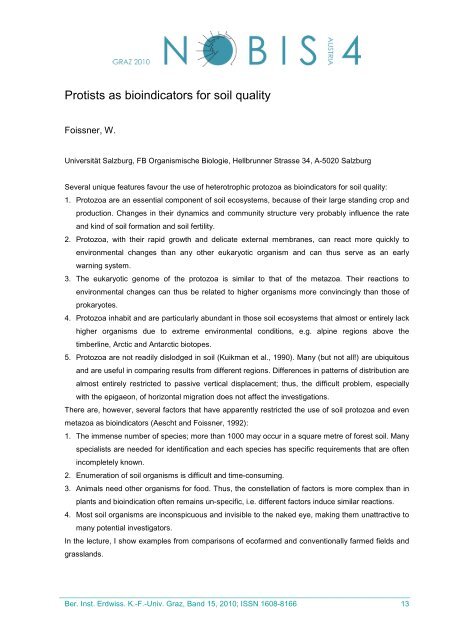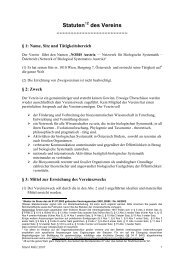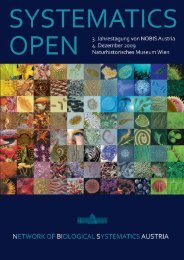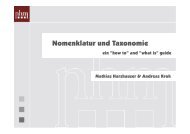4. Jahrestagung von NOBIS Austria 2. - 3. Dezember 2010
4. Jahrestagung von NOBIS Austria 2. - 3. Dezember 2010
4. Jahrestagung von NOBIS Austria 2. - 3. Dezember 2010
Create successful ePaper yourself
Turn your PDF publications into a flip-book with our unique Google optimized e-Paper software.
Protists as bioindicators for soil quality<br />
Foissner, W.<br />
Universität Salzburg, FB Organismische Biologie, Hellbrunner Strasse 34, A-5020 Salzburg<br />
Several unique features favour the use of heterotrophic protozoa as bioindicators for soil quality:<br />
1. Protozoa are an essential component of soil ecosystems, because of their large standing crop and<br />
production. Changes in their dynamics and community structure very probably influence the rate<br />
and kind of soil formation and soil fertility.<br />
<strong>2.</strong> Protozoa, with their rapid growth and delicate external membranes, can react more quickly to<br />
environmental changes than any other eukaryotic organism and can thus serve as an early<br />
warning system.<br />
<strong>3.</strong> The eukaryotic genome of the protozoa is similar to that of the metazoa. Their reactions to<br />
environmental changes can thus be related to higher organisms more convincingly than those of<br />
prokaryotes.<br />
<strong>4.</strong> Protozoa inhabit and are particularly abundant in those soil ecosystems that almost or entirely lack<br />
higher organisms due to extreme environmental conditions, e.g. alpine regions above the<br />
timberline, Arctic and Antarctic biotopes.<br />
5. Protozoa are not readily dislodged in soil (Kuikman et al., 1990). Many (but not all!) are ubiquitous<br />
and are useful in comparing results from different regions. Differences in patterns of distribution are<br />
almost entirely restricted to passive vertical displacement; thus, the difficult problem, especially<br />
with the epigaeon, of horizontal migration does not affect the investigations.<br />
There are, however, several factors that have apparently restricted the use of soil protozoa and even<br />
metazoa as bioindicators (Aescht and Foissner, 1992):<br />
1. The immense number of species; more than 1000 may occur in a square metre of forest soil. Many<br />
specialists are needed for identification and each species has specific requirements that are often<br />
incompletely known.<br />
<strong>2.</strong> Enumeration of soil organisms is difficult and time-consuming.<br />
<strong>3.</strong> Animals need other organisms for food. Thus, the constellation of factors is more complex than in<br />
plants and bioindication often remains un-specific, i.e. different factors induce similar reactions.<br />
<strong>4.</strong> Most soil organisms are inconspicuous and invisible to the naked eye, making them unattractive to<br />
many potential investigators.<br />
In the lecture, I show examples from comparisons of ecofarmed and conventionally farmed fields and<br />
grasslands.<br />
_____________________________________________________________________________<br />
Ber. Inst. Erdwiss. K.-F.-Univ. Graz, Band 15, <strong>2010</strong>; ISSN 1608-8166 13






